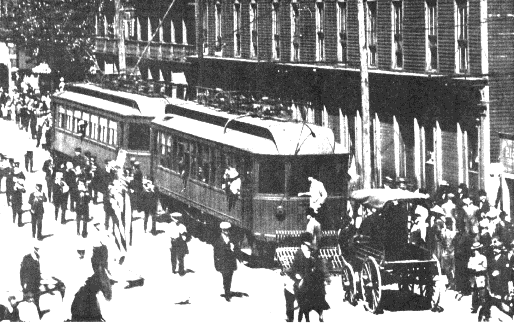
In 1905 these trolleys began service between
Warren, PA, and this South Main Street terminal in Jamestown, NY.
Trolleys ran local service on this line as far as Frewsburg. After
the economic crash in 1929 operations were discontinued.
Past Glories: Part II
The Trolley
by Juan Wilson
The Fenton Historical Society in Jamestown has
produced three excellent publications that document some of the past
glory of the Chautauqua region. This article is the second of a three
part series featuring these books which cover phenomena almost
extinct today: Steamboats, Hotels and Trolleys.
American cities adopted the horse drawn trolley as
a means of mass transit in the last quarter of the l9th century. By
1884 Jamestown had inaugurated horse cars between the Boat landing
and Windsor Street at Second. The horse barn and terminal waiting
room were near Main and Third Street in what became known as Sherman
House. Equipment consisted of thirteen wooden cars and forty-two
horses.
Soon after service began, A. N. Broadhead was
elected to the Board of Directors of the Jamestown Street Railway. He
later became its president and began his long history of influence on
transportation in the region. But it was not until the development of
the electric motor that the trolley car, as the vehicle of mass
transportation, became an integral part of American life. New York
State permitted the Jamestown Street Railway to go electric in
1890..
That year a powerhouse was built, and wires
strung. The motorized trolley quickly replaced the horse drawn
trolley with its speed, power and low maintenance. By the next year
several new lines were added including a track along Lakeview out to
the cemetery, a branch along Fairmount Avenue to Lakewood, and
another branch along Second Street to Falconer. Fourteen new electric
cars were in service. The cars were closed to the weather, with long
benches and carpeting. All runs began and ended at Sherman House, on
Third Street between Main and Cherry. Sherman House had a large
waiting room and transfers to any location could be made
there.
In mid-1893, A. N. Broadhead attended the World's
Columbian Exposition in Chicago. This enormous fair had influence on
the style of urban planning in America for decades. Broadhead came
away with an idea to build a recreational facility that would be the
destination of people traveling on his trolleys. The Jamestown Street
Railway built a line to the Village of Celeron and announced the
purchase of land there to be transformed into a park. The Phoenix
Ferris Wheel was purchased by the trolley company and operated by a
street car conductor. Other amusements were provided as well,
including a theater and a zoo.
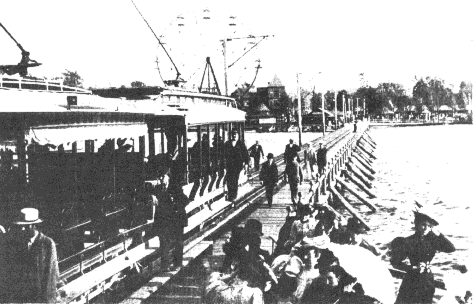
A turn of the century view of a trolley at the end
of the Celeron Park Pier at it meets a steamer boarding passengers
for a trip to Mayville. many travelers mixed trolley and steamboat
trips on their outings around Chautauqua Lake
Broadhead also bought a two decker trolley car
that had been promoted by C. L. Pullman at the Chicago fair.
Broadhead appropriately named it the Columbia. Seeing its
recreational and promotional value, he put it on a loop between the
plush hotels of Lakewood and Celeron Park and finally the Steamboat
Landing in Jamestown.
The Columbia became the most famous and popular
trolley car in the Chautauqua region. On the first deck one entered
from the side in the center of the car with a closed compartment fore
and aft. One was richly upholstered in green for the ladies, the
other appointed as a men's smoker. Upstairs was an open seating area.
It was said that the combination of an uneven roadbed and the well
sprung construction of the Columbia contributed to an exciting
"ocean-swell" ride on the upper deck. Celeron Park was very
successful. The demand for additional lines continued. A branch was
built up the steep hill of Forest Avenue to Newland. There was
expansion in every direction through the turn of the
century.
In 1903 the Broadhead family began securing
franchises through villages and towns on the west side of Chautauqua
Lake. A new railroad was formed, The Chautauqua Traction Company. The
Broadhead plan was to build a line along the west side of the lake to
Chautauqua Institute and beyond to Mayville.
Power houses were built in Mayville and Stow. At
that time the west side of the lake was so remote that bricks for the
Stow powerhouse were carried by ferry from Bemus Point. Soon
afterward service connected Lakewood to Ashville and from Ashville
north to Stow, Chautauqua and Mayville. Other recreational trolley
parks were created. The most popular on the west side of the lake was
Sylvan Park about a mile and a half north of Stow.
As early as 1887 steam locomotives of the
Jamestown, Chautauqua and Lake Erie Railroad worked their way north
and south, past Bemus Point, along the east side of the lake. By 1902
the line connected Jamestown to the Lakeshore & Michigan Southern
R.R. in Westfield. The Jamestown, Chautauqua and Lake Erie Railroad
(JC & LE RR) was commercially unsuccessful. Towards the end of
1913, the poorly run company was ripe for Broadhead to take over.
Once in hand, it was renamed the Jamestown, Westfield &
Northwestern Railroad (J.W. & N.W. RR or simply J.W.). It was
quickly converted to electric. A power cable was strung over the lake
from the Stow powerhouse to Bemus Point to feed the line. New steel
inter-urban trolleys were purchased.
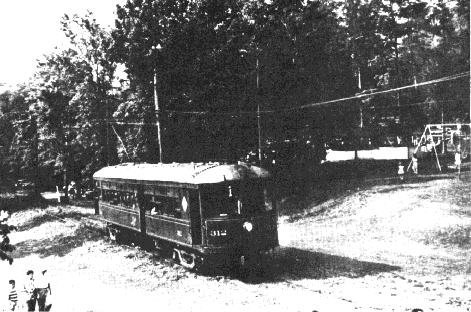
The view of a car entering Midway Trolley Park
from the roller rink. The park was built and owned by the railroad.
The run from Jamestown was about half an hour and several "picnic"
cars would leave Jamestown on saturday mornings for a day at
Midway.
The park at Midway was never much used, although
it had been purchased as a picnic ground by the old J.C. & L.E.
RR and it did have a steamship dock. The steam locomotive service was
irregular and the steamboats took as much as two hours
from
Jamestown. After 1913, once regular electric
trolley service began, Midway expanded with a merry-go-round, a
roller rink and other attractions. It became the most popular
destination other than Celeron Park, and was a significant source of
income for the railroad. In fact, it is one of the few activities
started then which is still in operation.
Besides mail and passenger traffic, dependable
freight was becoming an important service of the interurban railway
system. The Erie Railroad, that ran through Jamestown, was no longer
the only track into town. Competition came from rail connections in
Westfield and Mayville that could reach every small village around
the lake.
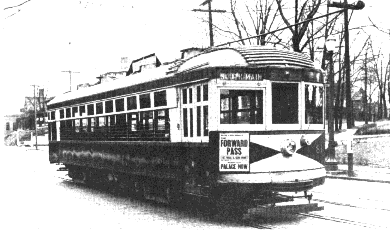
Car #81 was built in 1916 and added to the
Jamestown Street Railway. It is seen here on West Third Street and
Fairmount. In the 1920's and 30's trolleys would wait at Jones and
Gifford for Art MEtal Plant emplyees needing a ride
home.
The golden years for the trolleys were between
World War I and the mid twenties. In 1914 ten new large double truck
steel cars were added into service in Jamestown. They were bought
used from the New York Interborough Railway in Yonkers. Two years
later ten new cars arrived from the St. Louis Car Company. By 1918,
the Jamestown Street Railroad had seven lines running over twenty
trolleys on regular schedules. Special trains were used to handle
extra loads at the factories and to Celeron Park.
The Broadhead family had bought the remaining
active steamships and they controlled all the transportation on and
around Chautauqua Lake. The commuter, freight and recreational use of
this mass transit were coordinated well and were popular and
profitable. Then came Henry Ford and the Model T.
In the early 1920's few city households had
automobiles. But the roads were improving and automobile traffic was
increasing. Jamestown Street Railway even purchased its first three
buses in 1922. They bought truck chassis from the Pierce Arrow
company and had the trolley car builder, Kuhlman Car Company of
Cleveland, build the bodies.
By the late 20's more households had automobiles
and on grade intersections of car and trolley traffic was becoming a
bottleneck. It was also easier and cheaper to add gasoline driven bus
service than tear up streets and lay track. With buses, routes could
be changed or abandoned as traffic demanded.
The trolleys were becoming an unprofitable
novelty. In March of 1926 the Chautauqua Traction Company abandoned
the line from Ashville to Mayville. The Falconer line was cut from a
ten minute to twelve minute schedule. Throughout the system there was
retrenchment through rerouting and rescheduling.
By the mid 1930's, in the heart of the Depression,
trolleys in cities the size of Jamestown were a dying business. The
Jamestown Motorbus Company was a subsidiary of the Jamestown Street
Railway, and was running more buses than there were trolleys on
Jamestown streets.
In 1937 the Buffalo Transit Company bought the
Jamestown Street Railway for its bus lines and immediately applied to
the pubic service authority to abandon all the rail services. This
was granted and buses were brought to Jamestown to replace trolley
service. In the middle January in 1938 the trolleys in Jamestown
headed to the carbarn for the last time.
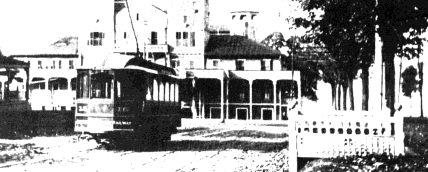
A trolley approaches the luxurious Sterlingworth
Inn at the foot of Chautauqua Avenue in Lakewood. After the Inn
burned the tracks were taken up.
There was still the Jamestown, Westfield and
Northwestern RR running up the east side of the lake. This was known
as "America's Scenic Route". It ran from the Union Passenger Station
in Jamestown to Westfield with six scheduled round trips a day. Mail
and freight service also ran on the line.
The terminal and carbarn in Jamestown was moved to
the Boat landing to reduce cost of downtown real estate. The
Jamestown-Westfield service struggled through the 30's. Finally, in
1940, The Broadhead Holding Company sold the J.W. to a New York City
group.
The Schenectady-Saratoga line stopped operations
the day before Pearl Harbor, leaving the J.W. as the last interurban
trolley system in New York State. The war and its demand for fuel
rationing forced people back onto the trolleys.
Businessmen rode the trolley to Westfield to catch
the Pullman connections east and west on the New York Central
Railroad. New commuter runs were scheduled between Bemus Point and
Jamestown. Ads in the local papers appeared for roller skating
excursions to Midway and trolley trips to the Point Chautauqua Golf
Course.
Trolley crews were accommodating in letting
passengers off in front of their lake cottages instead of the
designated stations when they were coming out from town. For a time,
while the war raged in distant places, the trolleys again enjoyed
popularity.
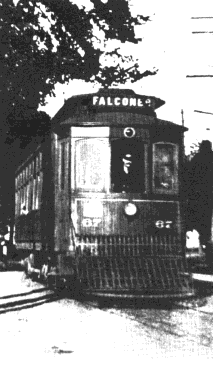
Trolleys on East Second Street of the falconer
Line once ran every ten minutes.
Then the war ended and gasoline was cheap again.
As a result of deferred maintenance and wear throughout the war, the
trolleys and track were in bad condition. In 1947 scheduled passenger
service was halted. Buses replaced them and two diesel locomotives
pulled what freight traffic was left. The electric trolleys ran no
more. With increasing derailments and equipment failure, the freight
service was discontinued in 1950 and local rail operations came to an
end here.
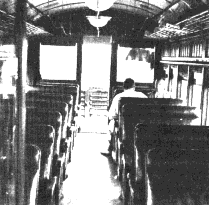
Interior of wooden trolley showing chanderier
lighting and leather seats.
On the west side of Chautauqua Lake there are
several stations still standing that belonged to the Chautauqua
Traction Company. One is in Ashville, opposite the General Store.
Incidentally, before the auto was mass produced, there was a plan to
extend service from the Ashville station through Blockville and into
Panama in order to alleviate the long coach ride from Ashville
station for tourists bound for Panama Rocks. Another standing station
is the impressive entrance building to Chautauqua Institute. Further
north at Light House Point is a grocery store housed in what was a
trolley station. Finally, in Mayville, with a beautiful vista of the
lake, is the station that now serves as a Railroad Museum.
Recently non-profit organization Chautauqua
Rails-To-Trails has been converting old railway right of ways to
trails for new recreational purposes--hiking, biking, skiing,
horseback riding and snowmobiling. For more information, check out
their website: www.cecomm.com/railstotrails
Click here to
read "Past Glories III: The Hotel
We congratulate the Fenton Museum for its superb
publication "Chautauqua Lake Trolleys" which was the source for this
article.. We urge those interested to visit the Fenton's gift shop
and purchase a copy. You may reach them at:
The Fenton Museum
Fenton Mansion
67 Washington Street
Jamestown, NY, 14701
(716) 664-6256
Hours: 10 am to 4 pm Monday through Saturday

